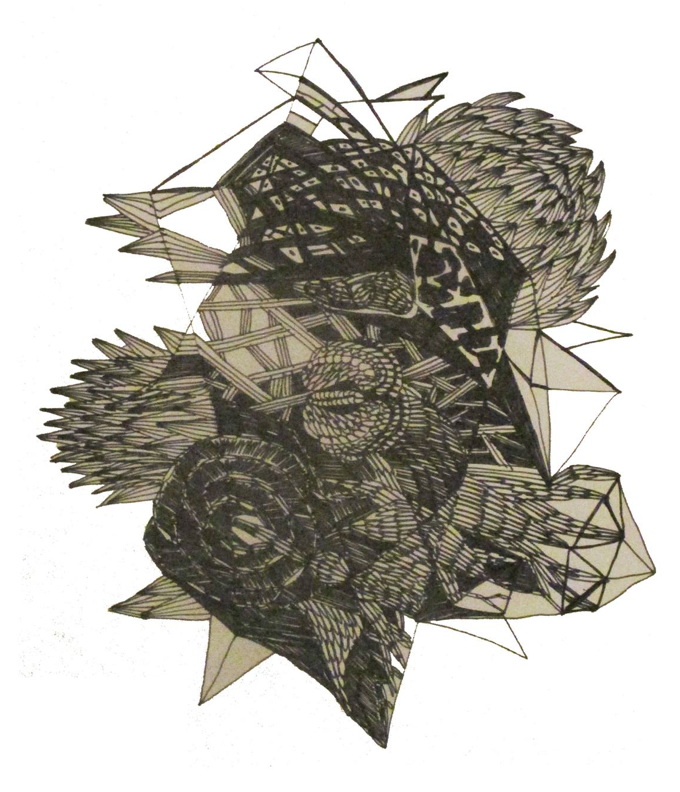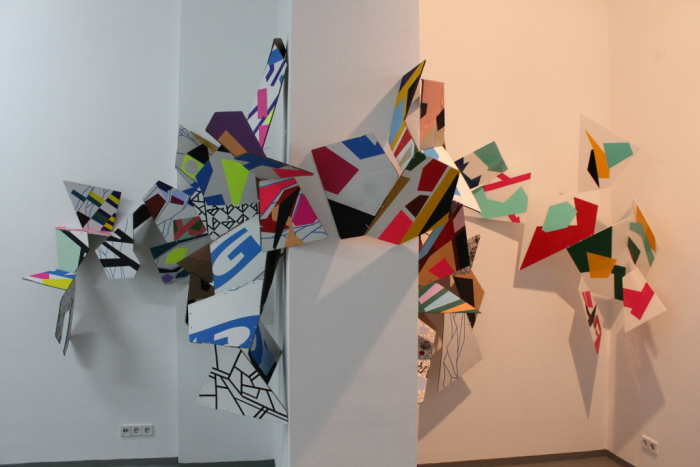Eröffnung: Fr. 30.01.2015 – 19 Uhr
Ausstellung: 31.01. – 08.02.2015 – Do -So 15-19 Uhr
In der Ausstellungsreihe Ekvalizator / Entzerrer, wollen wir in 2015/2016 in lockerer Folge junge Künstlerinnen und Künstler aus Berlin und Mittelosteuropa einladen, gemeinsam eine Ausstellung in der Zwitschermaschine zu gestalten. Entzerrer – weil wir diese Reihe als Beitrag zu dem nach wie vor laufenden Prozess einer west-östlichen Entzerrung in der gegenseitigen Wahrnehmung verstehen. Ausgleichen ohne anzugleichen – könnte das Motto lauten.
4. Pax | Uaxac Chuen | 31. Ledna
Import von Touristen, Export von Kaffee. Inmitten der Bananenplantagen suchen wir trinkbares Wasser. Unter den kolonialen Anschwemmungen, tief, auf einer Klinge aus Obsidian, spiegeln sich die Auswirkungen des spanischen Kolonialismus, des US-amerikanischen freien Marktes, des deutschen Kommunismus.Invasives Strauchwerk versuchen wir mit dem ungeübten Blick des Europäers von den verwucherten Formen der ursprünglichen Maya-Sprachen zu unterscheiden– manchmal im subtropischen Nebelwald, manchmal knöcheltief im Müll an den Ufern des Pazifiks. Und sie? Sie haben das Wurzelsystem der Manilkara zapota, des Breiapfelbaums verlassen, das tief eingesenkt ist in die Tempelfundamente der frühen klassischen Periode. Gelingt es ihnen die Wurzeln des alltäglichen europäischen Postmodernismus in der Spätphase des Kapitalismus freizulegen? Wir haben nicht die Macht wieder gutzumachen, wir versuchen nur zu reflektieren. Wir suchen, fokussieren auf das, was eine globale Ökonomie entschieden hat, im Rahmen der lokalen Kultur Mittelamerikas zu erhalten.
Mitteleuropäer in Mittelamerika, Mittelamerikaner in Mitteleuropa. Tausende von Kilometern zurückgelegt, konfrontiert mit Verschiedenheit, eingelullt von Homogenität. Die junge Künstlerin aus Tschechien, Eva Jaskova, reist und performt in Einem. Sie verliert sich in dem Gestrüpp und der Mannigfaltigkeit der Kulturen und findet neue Zugänge, kombiniert verschiedene Medien und Materialien. Der in Berlin lebende mexikanische Künstler Guillermo Aguilar-Huerta ist fasziniert von den astrologischen Beobachtungen der Ureinwohner, in denen er den Ausgangspunkt für seine Arbeit findet. Er arbeitet mit Installationen, dem Raum, den Beziehungen zwischen den einzelnen Elementen seiner Objekte, mit kosmologischer Vision und folkloristischem Ornament.
Import of tourist, export of cafe. In the middle of a plantation of bananas, we search for potable water. Underneath the colonial silt, on obsidian blade is mirroring the implications of features of Spanish colonialism, American free trade system, German communism. Invasive species of plants we are trying to distinguish from uncultivated dialects of ancient Mayan languages, in the rain forest, or knee deep in rubbish, on the pacific shores. And They? They have abandoned the roots of the Manilkara zapota, the Sapodilla embedded in the foundations of the early classical period temple. Will they find the roots of the European everyday postmodernism in the late period of capitalism? We are not trying to rectify, we are trying just to reflect. Search, focused to find what global economy decided to preserve from the local cultures of Mesoamerica.
Middle Europeans in Middle America, Middle Americans in the Middle of Europe. They are covering thousands of kilometres, confronted by diversity, lulled by homogeneity. The young artist From Czech Republic, Eva Jašková, traveling and performing at once. She is disappearing under the jumble and variety of world cultures; she is finding new approaches, combining different medias. The Mexican artist Guillermo Aguilar-Huerta, based in Berlin, fascinated by astrological observations of the indigenous people, in which he finds the foundations for his creation. He is working with installation, space, relations between individual objects, cosmological-visions as well as folklore ornaments.
Guillermo Aguilar-Huerta
I was born in Monterrey Mexico. Since 2007 I have been living and working in Berlin. I place my work into the discourse that exists between fashion, industrial design and concrete forms. In my artwork, geometrical abstractions dominate with a variety of exotic colour combinations, which are derived from universal and traditional Mexican patterns.
That´s because i particularly work with geometry because it is an endless way to create unique shapes that describe different cultures. Furthermore, I ascribe a major importance to architecture and technological advancement to capture how all these combinations of factors influence our modern society.
My compositions are clearly determined by the mixture of both, namely my own and universal pattern creations which are adapted to individual geometrical shapes. Hence, reflecting my viewpoint about life in all its diversity and dynamism.
http://gahuert.com
Eva Jašková
“Despite all the technological apparatus that Eva Jašková uses in the creation, she is a dormant romantic. How else to explain her desire for the immediate experience of the landscape, as well as her efforts to decipher the reasons for our aesthetic preferences of a particular place. It have been precisely the Romantics, which as the first were able to enjoy the simple landscapes and it was in the Romantic period, when a theory of aesthetic subjectivism has been formed – declaring that beauty is not directly intrinsic to things, but that is shapes only in the mind of the observer (D. Hume). Jašková but does not resort to nature because she probably – like the Romantics – feels disenchanted with the state of contemporary society and seeks refuge „in the forest canopy“ before the wicked world. Her reasons are different already only because she accepts the present technical civilization – and all its accompanying signs. Otherwise she could hardly cope with her current „ecological footprint“ – already now – no doubt – much longer than the traces of their parents or grandparents. And she could hardly considered herself as a nomad whose home is the entire world. In the spirit of the famous paradox “faraway, so close” her long separation from home made her think about her roots and she experienced every home-coming more intensely. The catalyst for the author’s feelings became a landscape, but not just in the sense of a individual identification with it, but as well as the active need to imprint something on it of herself. In the intimate known surroundings of her native region she therefore carried out several “ voice intervention“, which according to her are the most direct way to achieve a blend of „I“ with the environment. Jašková interprets this sound with an almost esoteric tinge. For her it does not only represent another communication channel, but also the harmonizing factor to merge through its vibrancy the creature with the environment.“ (Thomas Knoflíček)
http://jaskova.blogspot.de

